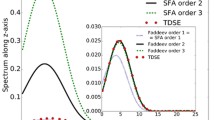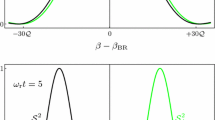Abstract
The interaction between atoms and molecules and intense laser pulses is typically described in either the velocity gauge, length gauge or in the Kramers–Henneberger frame. Here, certain relations between these forms are discussed. In particular expansions of the solution to the time-dependent Schrödinger equation in adiabatic states are considered. Such expansions in adiabatic states could be expected to be attractive for intense long-wavelength infrared laser pulses, where the external field changes on a slow timescale compared with the electron motion. It is shown that an expansion in velocity gauge adiabatic states gives the equations of motions that follow from an expansion in field-free states and by expressing the interaction operator in the length gauge. Likewise, it is shown that an expansion in the Kramers–Henneberger frame adiabatic states gives the equations of motion following an expansion in field-free states and using the velocity gauge interaction operator. Finally, an alternative form for the laser–matter interaction operator is considered, which is similar to the velocity gauge, but shifts the canonical momentum operator by the impulse associated with the Kramers–Henneberger interaction operator, rather than that of the electric field as is the case in the velocity gauge.
Similar content being viewed by others
References
S.V.B. Jensen, M.M. Lund, L.B. Madsen, Nondipole strong-field-approximation Hamiltonian. Phys. Rev. A 101, 043408 (2020). https://doi.org/10.1103/PhysRevA.101.043408. https://link.aps.org/doi/10.1103/PhysRevA.101.043408
E. Cormier, P. Lambropoulos, Optimal gauge and gauge invariance in non-perturbative time-dependent calculation of above-threshold ionization. J. Phys. B Atom. Mol. Opt. Phys. 29(9), 1667–1680 (1996). https://doi.org/10.1088/0953-4075/29/9/013
A. Ludwig, J. Maurer, B.W. Mayer, C.R. Phillips, L. Gallmann, U. Keller, Breakdown of the dipole approximation in strong-field ionization. Phys. Rev. Lett. 113, 243001 (2014). https://doi.org/10.1103/PhysRevLett.113.243001
H.R. Reiss, Limits on tunneling theories of strong-field ionization. Phys. Rev. Lett. 101, 043002 (2008). https://doi.org/10.1103/PhysRevLett.101.043002. https://link.aps.org/doi/10.1103/PhysRevLett.101.043002
J.J. Sakurai, Modern Quantum Mechanics (Addison-Wesley Publishing Company Inc, Reading, 1994)
L.B. Madsen, Gauge invariance in the interaction between atoms and few-cycle laser pulses. Phys. Rev. A 65, 053417 (2002). https://doi.org/10.1103/PhysRevA.65.053417. https://link.aps.org/doi/10.1103/PhysRevA.65.053417
L.V. Keldysh, Ionization in the field of a strong electromagnetic wave. Sov. Phys. JETP 20, 1307 (1965)
F.H.M. Faisal, Multiple absorption of laser photons by atoms. J. Phys. B 6(4), L89–L92 (1973). https://doi.org/10.1088/0022-3700/6/4/011
H.R. Reiss, Effect of an intense electromagnetic field on a weakly bound system. Phys. Rev. A 22, 1786–1813 (1980). https://doi.org/10.1103/PhysRevA.22.1786. https://link.aps.org/doi/10.1103/PhysRevA.22.1786
D. Bauer, D.B. Milošević, W. Becker, Strong-field approximation for intense-laser-atom processes: the choice of gauge. Phys. Rev. A 72, 023415 (2005). https://doi.org/10.1103/PhysRevA.72.023415. https://link.aps.org/doi/10.1103/PhysRevA.72.023415
T.K. Kjeldsen, L.B. Madsen, Strong-field ionization of \({N}_2\): length and velocity gauge strong-field approximation and tunnelling theory. J. Phys. B Atom. Mol. Opt. Phys. 37(10), 2033–2044 (2004). https://doi.org/10.1088/0953-4075/37/10/003
M. Gavrila, J.Z. Kamiński, Free–free transitions in intense high-frequency laser fields. Phys. Rev. Lett. 52, 613–616 (1984). https://doi.org/10.1103/PhysRevLett.52.613. https://link.aps.org/doi/10.1103/PhysRevLett.52.613
H.G. Muller, An efficient propagation scheme for the time-dependent Schrödinger equation in the velocity gauge. Laser Phys. 9, 138–148 (1999)
D. Bauer, P. Koval, Qprop: A Schrödinger-solver for intense laser–atom interaction. Comput. Phys. Commun. 174(5):396–421 (2006). ISSN 0010-4655. https://doi.org/10.1016/j.cpc.2005.11.001. http://www.sciencedirect.com/science/article/pii/S0010465505005825
T.K. Kjeldsen, L.A.A. Nikolopoulos, L.B. Madsen, Solving the \(m\)-mixing problem for the three-dimensional time-dependent Schrödinger equation by rotations: application to strong-field ionization of \({\rm H}_{2}^{+}\). Phys. Rev. A 75, 063427 (2007). https://doi.org/10.1103/PhysRevA.75.063427. https://link.aps.org/doi/10.1103/PhysRevA.75.063427
S. Patchkovskii, H.G. Muller, Simple, accurate, and efficient implementation of 1-electron atomic time-dependent Schrödinger equation in spherical coordinates. Comput. Phys. Commun. 199:153–169 (2016). ISSN 0010-4655. https://doi.org/10.1016/j.cpc.2015.10.014. http://www.sciencedirect.com/science/article/pii/S001046551500394X
M.V. Berry, Quantal phase factors accompanying adiabatic changes. Proc. R. Soc. Lond. A Math. Phys. Sci. 392(1802):45–57 (1984). https://doi.org/10.1098/rspa.1984.0023. https://royalsocietypublishing.org/doi/abs/10.1098/rspa.1984.0023
W.V. Houston, Acceleration of electrons in a crystal lattice. Phys. Rev. 57, 184–186 (1940) https://doi.org/10.1103/PhysRev.57.184. https://link.aps.org/doi/10.1103/PhysRev.57.184
W. Mengxi, S. Ghimire, D.A. Reis, K.J. Schafer, M.B. Gaarde, High-harmonic generation from Bloch electrons in solids. Phys. Rev. A 91, 043839 (2015). https://doi.org/10.1103/PhysRevA.91.043839. https://link.aps.org/doi/10.1103/PhysRevA.91.043839
S.Y. Kruchinin, F. Krausz, V.S. Yakovlev, Colloquium: Strong-field phenomena in periodic systems. Rev. Mod. Phys. 90:021002 (2018). https://doi.org/10.1103/RevModPhys.90.021002. https://link.aps.org/doi/10.1103/RevModPhys.90.021002
R.G. Newton, Scattering Theory of Waves and Particles (Springer, New York, 1982)
L.O. Krainov, P.A. Batishchev, O.I. Tolstikhin, Siegert pseudostate formulation of scattering theory: general three-dimensional case. Phys. Rev. A 93, 042706 (2016). https://doi.org/10.1103/PhysRevA.93.042706. https://link.aps.org/doi/10.1103/PhysRevA.93.042706
H.A. Bethe, E.E. Salpeter, Quantum Mechanics of One and Two-Electron Atoms (Plenum, New York, 1977)
H. Miyagi, L.B. Madsen, Exterior time scaling with the stiffness-free Lanczos time propagator: formulation and application to atoms interacting with strong midinfrared lasers. Phys. Rev. A 93, 033420 (2016). https://doi.org/10.1103/PhysRevA.93.033420. https://link.aps.org/doi/10.1103/PhysRevA.93.033420
D. Dimitrovski, E.A. Solovev, Ionization of negative ions and atoms by electric pulses: zigzag dependence on pulse duration. J. Phys. B Atom. Mol. Opt. Phys. 39(4), 895–903 (2006). https://doi.org/10.1088/0953-4075/39/4/013
Acknowledgements
The author thanks Simon Vendelbo Bylling Jensen for useful discussions. This work was supported by the Danish Council for Independent Research (Grant nos. 7014-00092B, 9040-00001B).
Author information
Authors and Affiliations
Contributions
The author conceived the idea regarding elucidation of the relations between the equations of motion after expansion in adiabatic states with equations of motion following the expansion in field-free states. The author derived the presented relations and formulas. The author wrote the manuscript.
Corresponding author
Rights and permissions
About this article
Cite this article
Madsen, L.B. Different forms of laser–matter interaction operators and expansion in adiabatic states. Eur. Phys. J. Spec. Top. 230, 4141–4150 (2021). https://doi.org/10.1140/epjs/s11734-021-00026-y
Received:
Accepted:
Published:
Issue Date:
DOI: https://doi.org/10.1140/epjs/s11734-021-00026-y




